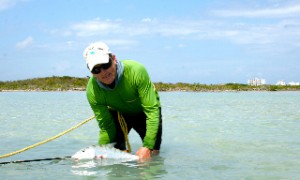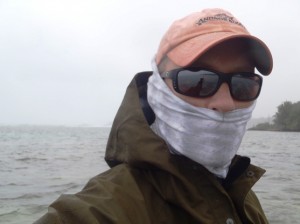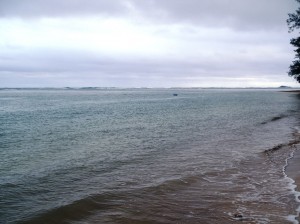Here is a place probably worth seeing. This is Jardines De La Reina in Cuba and a little collection of photos by Jim Klug.
Archives
15
Dec 11
Turneffe Atoll Marine Reserve – Worth Supporting

The good folks at the Turneffe Atoll Trust are trying to get signatures for a proposed Tuneffe Atoll Marine Reserve. It’s a good idea. (You can go to this site to express your support)
Belize in general has really come a long way toward embracing conservation… as they should. Tourism is an important part of the Belizean economy and that only works if they have wonderful places to show people. TAT is pretty new to the scene, but they are already engaged in some pretty exciting work.
So, spend a little time to do what they are asking you to do. I’ll be doing it myself as well.
Dear Bonefish on the Brain readers,
I am going to ask for a moment of your time regarding something that is incredibly important for the future of our industry and the future of saltwater marine environments in the Caribbean.
We aren’t asking for any money, but we need your voice of support! As an esteemed member of the fly fishing community, you are no doubt concerned by the mounting threats against coastal ecosystems around the globe. The future of saltwater angling depends on the integrity of places such as Turneffe Atoll, Belize – the largest and most biologically diverse atoll in the Western Hemisphere.
Nearly a decade ago, Turneffe Atoll Trust was formed to help implement an environmental success story, one in which a globally significant ecosystem gained protection before an environmental crisis hit. Turneffe Atoll is currently healthy and as of yet, does not need to be fixed. What it urgently needs, however, is protection and management so it doesn’t fall victim to further improper development, unsustainable commercial activities, and environmental degradation.
The great news is that this goal is within reach because the Government of Belize has recently indicated it is prepared to formally designate a new Turneffe Atoll Marine Reserve. An achievement of this magnitude bodes well not only for the future of Belize, but also for all who have a stake in marine conservation and saltwater fisheries throughout the Caribbean basin. This is why I am asking you to help with a final push towards making this dream a reality.
Send an email to Paul (paul@turneffeatoll.org), with the following three (3) quick and simple pieces of information, you will be added as an endorser to a letter asking the Belizean Minister of Fisheries and Agriculture for the creation of a Turneffe Atoll Marine Reserve (see the letter below):
1. Name of your business / organization
2. Name and title of individual signing on behalf of business / organization
3. Your City, State, and Country
If all goes as planned, our goal is to celebrate this victory by the end of January 2012. Your support is key to making this happen, and we very much appreciate your time and your endorsement!
Best regards,
Paul D. Robertson
Executive Director
Here is the letter you’ll be added to…
Honorable Rene Montero
Minister of Agriculture and Fisheries
P.O. Box 146
Belize City, Belize
Honorable Minister Montero:
We, the undersigned, wish to formally express our complete and total support for the creation of a Turneffe Atoll Marine Reserve. By taking this historic step, the Government of Belize will not only secure benefits for all future generations of Belizeans, but it will also make a major contribution in the global effort to conserve the marine environment.
As the largest and most biologically diverse atoll in the Western Hemisphere, Turneffe Atoll encompasses all aspects of an intact coastal marine ecosystem; including deep ocean, fringe reef, patch reef, back-reef flats, extensive sea grass beds, extensive mangrove stands, creeks, littoral forest and two large lagoon systems. It is home to populations of several threatened species including Antillean manatees, Hawksbill turtles, goliath groupers, Nassau grouper and American crocodiles. Six spawning aggregation sites are known at Turneffe. With this rich diversity of coastal marine habitats, Turneffe is also an ideal location to conduct critical coastal marine research.
Additionally, the health of Turneffe Atoll is vital to the Belizean economy. A traditional fishing ground since the Mayan era, Turneffe is one of Belize’s largest producers of spiny lobster, conch and finfish. It is an increasingly popular tourism destination and the diving, fly fishing, and eco-tourism opportunities are world-renowned. These commercial activities provide significant employment for Belizeans and sustainable management of these resources is essential to ensuring a continuous source of stable jobs.
By all measures Turneffe Atoll is an irreplaceable asset to the cultural heritage of Belize. By taking this huge step forward, Belize will further solidify its position as a global leader in environmental stewardship and forward thinking. We urge you to make this landmark achievement a reality by designating a Marine Reserve at Turneffe Atoll.
Sincerely,
(this is where your name will show up)
Again, thank you for replying to this email with these 3 pieces of information and voicing your support for a Turneffe Atoll Marine Reserve:
1. Name of your business / organization
2. Name and title of individual signing on behalf of business / organization
Your City, State, and Country
14
Dec 11
Bonefish decline in FL
Well… this is interesting. Looks like bones have been on the decline in FL for a while now and the Bonefish and Tarpon Trust is going to try and get to the bottom of it.
UPPER KEYS — Bonefish are among the most iconic of Florida Keys sportfish. But with the local population of the legendary “gray ghosts” believed to have declined over the past several decades, a prominent conservation organization is seeking to find out why.
The prey study comes on the heels of a dissertation completed over the summer which concluded that the South Florida bonefish stock has declined 70 percent since anglers descended in large numbers upon the region and began targeting the species as a premier sportfish.
Wow… 70%. That’s shocking and sobering and maybe a little depressing.
Knowledge is the key here so I’m glad BTT is on the case.
12
Dec 11
The goodness that is BTT, via Orvis
Over the last decade, the organization, now called Bonefish & Tarpon Trust, has grown into a many tentacled beast—providing funding for research, supporting conservation efforts, educating sport fishermen, working with regulatory authorities and legislators, and serving as “a repository of information and knowledge related to the life cycle, behavior, and well being of the species.” Such an effort requires a leader who understands the scientific concepts and the many different perspectives involved in any debate about the future of marine habitats. Since 2006, that man has been Dr. Aaron Adams, whose impeccable “street cred”—as a scientist, and author, and angler—have helped recreational anglers make the connection between BTU’s research and what’s happening on the water. (see the rest f the story here)
This piece profiles Aaron Adams and the work of the Bonefish & Tarpon Trust.
Good stuff.

BTT's Aaron Adams scouting out El Pescador
06
Dec 11
Some notes on my trip to Kauai
OK… if I had just slayed them, I probably would be a little more elusive about where exactly I went. However, having spent 3 & 1/2 days in pursuit of bones in Kauai, I feel comfortable revealing which island I was on.
Mainly, I feel comfortable doing so because if you head to Kauai with the sole intention of catching bonefish, you are mad… MAD, MAD, MAD!
I certainly won’t go back to Kauai JUST for the fishing. I may very well go back there. I love that place. If I go back, I’ll bring a rod, for sure. However, the fishing leaves a lot to be desired… like a lot more fish that are considerably less spooky and much more easy to find… to name a few attributes that could improve things a tad.
I wrote down a list of thoughts I had from the trip… here are a few:
- Sleeping bags in damp, warm places are not really very comfortable.
- Of the 4 shots I had, 3 were to single fish in deeper water, 3 feet or so. If that’s where the fish are hanging out, it makes more sense why they were hard to find.
- I didn’t see a single bonefish predator.
- Rain gear was essential.
- There were some bait guys out there… the kind where you stick the rod in a holder and wait for the bell to ring. I never saw them catch anything.
- The Redington Predator cast well for a big rod. No complaints.
- I didn’t see a bonefish really tail (I did see tails, but those fish, unlike the deep water fish, were in really skinny water and I think they were just so big their fins were out of the water).
- I didn’t see a bonefish push water.
- There were guys hitting golf balls out into the ocean. There were hundreds of golf balls in the sand and on the flats. Those guys are tools.
- Getting out on those big flats was easy, but walking back, when the lights went off, was challenging.
- I have a new appreciation for fish that feed readily and are plentiful.
- At the campground there were a LOT of hippies. More than a few people seemed to be living there.
- Roosters sever as the wake-up call, starting at about 5:30.

Yeah... not what you think of when you picture Hawaii.
05
Dec 11
Luckily, the trip was about more than just the fish
I’m in a cafe in Hawaii at the moment… I’m all packed up and killing a bit of time before I have to get on the flight back the Bay Area.
The trip was a good one, as long as we don’t look at it strictly in fishing terms. I had a few reasons to head here and fishing was only one of them. In many ways this was a trip to bring the last 8 years of my life full circle and I think I accomplished that. Another reason to come here was this is where I saw my first bonefish, about 4 years ago. The experience had a bit of an impact on me and I always wanted to come back to have another shot at those fish.
The first couple of days the weather was considerably less than ideal. High winds, constant cloud cover and a good smattering of rain really put the damper on things… literally and figuratively.

Hard to see the fish with out the lights on.
The weather broke a bit on Saturday and I had a good amount of time with the lights on. No bones even seen.
Sunday… Sunday was what I was really here for. I walked out onto the flat and saw what looked like a bonefish feed mark. I took a picture. 20 seconds later I saw my first bonefish of the trip and 30 seconds later I spooked my first bonefish of the trip.

Much better conditions
I came back to that spot three more times and the next two I found single fish and at each occasion the fish spooked on the cast. Fly hit the water and the fish bolted. These fish are SUPER SPOOKY. They were in deeper water, maybe 3 feet, and I was lucky to see them at all.
Later, at low, low tide, I was walking really far out on a big rubble flat and I saw tails. I don’t even think they were tailing, I think they were swiming in water that was about 5-6″ deep. I got two casts in before they bolted, never to be seen again.
Sunday was a day of shots. I had them. I can’t argue with that. I didn’t convert any, but I had shots. I found the fish, on multiple occasions. Turns out these fish are a bit tougher than I planned on.
I’ll post some more pics and go into things a bit more in the coming days.
20
Nov 11
A trip to Andros (not mine)
OK… so, another video. I have a post I want to put up, but it needs to wait until Monday when more eyes can see it. Until then, these anglers will take you on their trip to Andros.
14
Nov 11
Guides making it look easy
Well… guides can really make this look easy. Here we have a guide in Andros make a backhand cast in some decent wind and hookup pretty much instantly.
Sure made that look easy.





